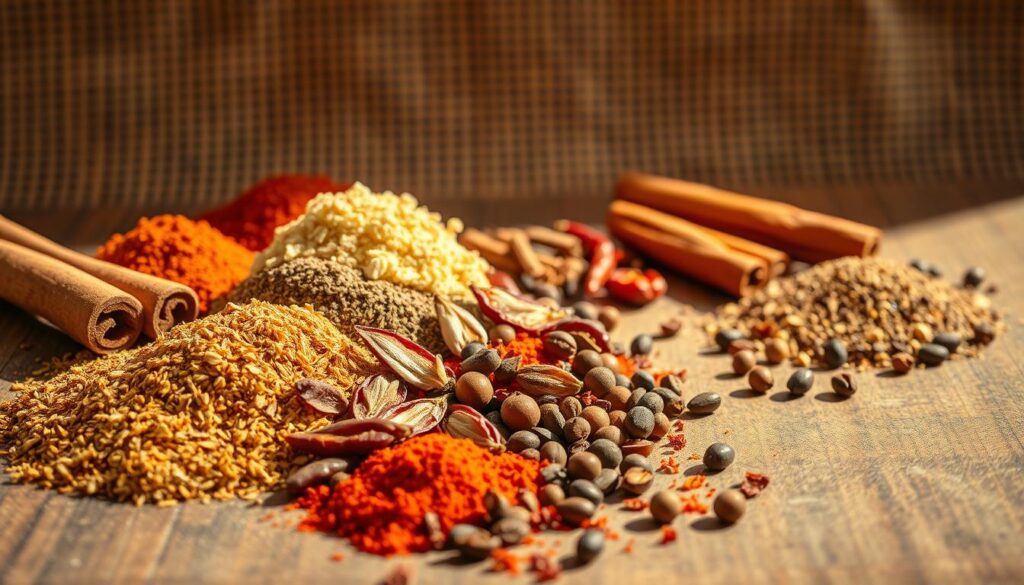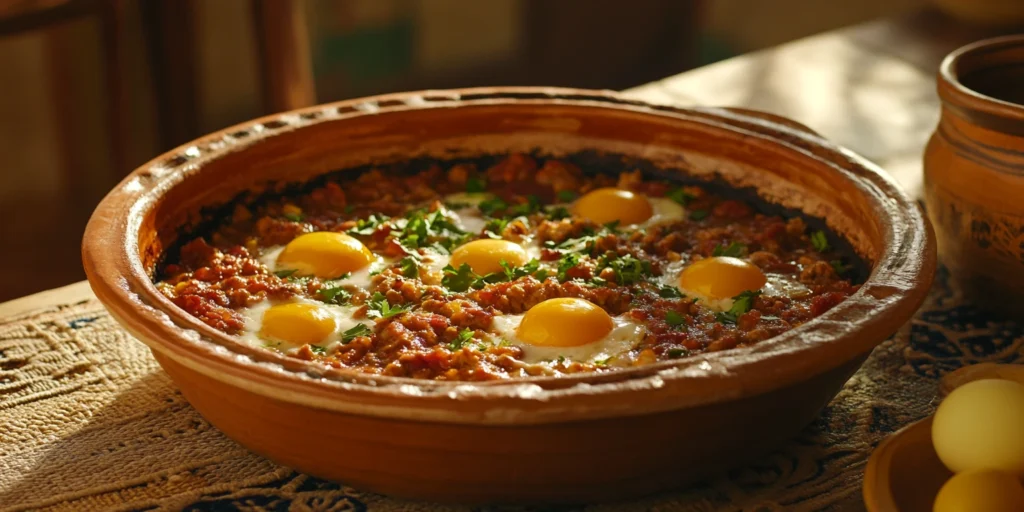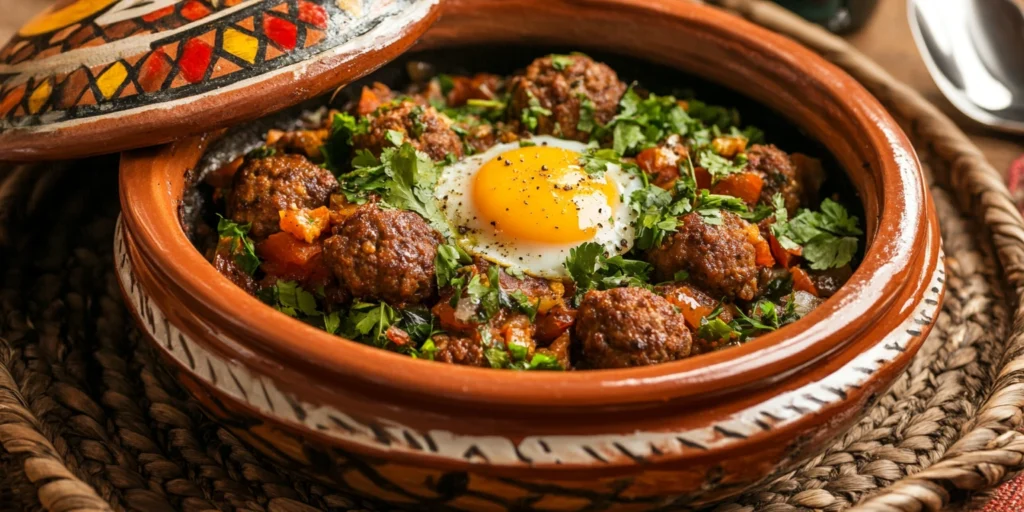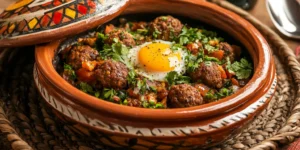The first time I tasted Kefta Tagine with Eggs in a small Marrakech kitchen, something magical happened. The rich aroma of spiced lamb meatballs simmering in a vibrant tomato sauce, topped with perfectly poached eggs, transported me into the heart of Moroccan culinary tradition.
Tagine Kefta Mkaouara is more than just a meal. It’s a sensory journey through Morocco’s rich gastronomic landscape. This beloved Moroccan cuisine staple combines tender lamb meatballs, aromatic spices, and a luscious tomato sauce. It tells a story of generations of home cooks perfecting their craft.
Imagine bringing a piece of North African culinary magic into your own kitchen. Each bite of this comforting dish promises to awaken your taste buds. It introduces you to the warmth and hospitality embedded in traditional Moroccan cooking.
Introduction to Authentic Moroccan Kefta Tagine
Explore the rich world of North African flavors with a journey into Moroccan kefta tagine. This dish is at the heart of Berber culinary heritage. It tells a story of tradition, family, and amazing taste passed down through generations.

Kefta tagine is more than a meal; it’s a cultural experience. It captures the essence of Moroccan cooking. The traditional clay pot cooking method turns simple ingredients into a flavorful symphony. It takes you to the bustling markets and warm kitchens of North Africa.
Origins and Cultural Significance
The roots of kefta tagine are deep in Moroccan culinary traditions. This dish comes from the resourceful Berber communities. They mastered the art of making delicious meals with limited ingredients. Key aspects of its cultural importance include:
- A staple of family gatherings and celebrations
- Represents the communal nature of Moroccan dining
- Showcases the ingenious cooking techniques of North African cuisine
Traditional Preparation Methods
Preparing kefta tagine is an art form that requires patience and skill. The slow-cooking process in a traditional clay tagine pot allows flavors to meld and intensify. This creates a dish that is both rustic and sophisticated.
Regional Variations
Across Morocco, each region adds its unique touch to the classic kefta tagine. From the coastal areas to the mountainous regions, you’ll find subtle differences. These differences reflect local traditions and available ingredients.
Essential Ingredients and Spice Blend
Making a real Moroccan Kefta Tagine starts with top-notch ingredients. These ingredients mix together to create a dish full of flavor. The spice blend and quality ingredients turn simple parts into a work of art.

Choosing the right meat is key. Chefs often pick lamb or beef, finely ground. This lets the spices mix well with the meat. The meat is like a blank canvas for the harissa spice blend, adding warmth and depth.
Key Spices and Aromatics
- Ground cumin
- Coriander
- Cinnamon
- Ground ginger
- Smoked paprika
- Turmeric
The saffron-spiced tomato sauce is special because of the spice balance. Fresh garlic and onion add to the flavor. Preserved lemon brings a tangy brightness that makes the dish stand out.
Essential Herb and Ingredient Breakdown
| Category | Ingredients | Purpose |
|---|---|---|
| Herbs | Fresh parsley, cilantro | Add freshness and brightness |
| Base | Canned diced tomatoes, tomato paste | Create rich sauce foundation |
| Binding | Eggs | Add protein and texture |
Knowing these ingredients makes your Kefta Tagine more than just a meal. It becomes a true Moroccan experience. Each part is important for the dish’s complex, layered flavors.
Kefta Tagine with Eggs (Tagine Kefta Mkaouara)
Dive into the heart of Moroccan cuisine with this classic lamb meatball dish. It combines rich flavors and traditional cooking techniques. The Kefta Tagine is a perfect mix of spices, texture, and culinary artistry. It will take your taste buds to the bustling markets of Morocco.

Crafting the Perfect Lamb Meatballs
Creating authentic lamb meatballs requires attention to detail and the right ingredients. Your Moroccan cuisine adventure starts with selecting high-quality ground lamb and a carefully curated spice mixture. Here’s what you’ll need:
- Fresh ground lamb
- Finely chopped onions
- Fresh parsley and cilantro
- Ground cumin
- Paprika
- Salt and pepper
Building the Saffron-Spiced Tomato Sauce
The soul of this dish lies in its vibrant saffron-spiced tomato sauce. You’ll want to build layers of flavor by slowly simmering ripe tomatoes with aromatic spices. The key is to create a rich, deep sauce that will perfectly complement your lamb meatballs.
“In Moroccan cooking, patience is not just a virtue—it’s an essential ingredient.” – Moroccan Culinary Tradition
Mastering the Poached Egg Technique
The final touch to your Kefta Tagine is the perfectly poached eggs. Gently crack fresh eggs directly into the simmering tomato sauce. Let them cook until the whites are set but the yolks remain delightfully runny. This technique creates a luxurious sauce that brings the entire dish together.
Your Kefta Tagine with eggs is more than a meal—it’s a culinary journey through the rich traditions of Moroccan cuisine.
Cooking Equipment and Traditional Tagine Use
Exploring traditional clay pot cooking shows the essence of North African flavors in Moroccan cuisine. The tagine, a unique clay cooking vessel, is at the heart of authentic Moroccan cooking. Its cone-shaped design is not just pretty—it’s a work of art that turns simple ingredients into amazing dishes.
Using a traditional tagine changes your cooking experience. The pot’s shape lets steam move around, making food tender and adding deep flavors.
- Clay tagine: Ideal for slow-cooking and flavor concentration
- Dutch oven: Excellent alternative for home cooks
- Heavy-bottomed pan: Suitable substitute when traditional equipment is unavailable
When picking your cooking vessel, look for these key traits of traditional clay pot cooking:
| Cooking Vessel | Heat Retention | Flavor Intensity | Recommended Use |
|---|---|---|---|
| Clay Tagine | Excellent | Maximum | Authentic Moroccan dishes |
| Dutch Oven | Very Good | High | Home cooking adaptations |
| Heavy-Bottomed Pan | Good | Moderate | Quick meal preparation |
Proper care of your tagine keeps it lasting long and working well. Always season your clay pot before first use by soaking it in water and heating it up slowly to avoid cracking. Wash it by hand with mild soap and avoid sudden temperature changes to keep it in good shape.
Serving Suggestions and Accompaniments
Make your Moroccan meal special by adding the right sides and presentation. This turns a traditional dish into a feast for the senses.
Traditional Bread Options
Bread is key in Moroccan meals, used as both a utensil and flavor booster. Here are some breads that go great with kefta tagine:
- Khobz: A dense, round Moroccan bread perfect for sauce
- Msemen: Flaky, layered flatbread that pairs well with the tagine
- Pita: A good choice that works well with the dish
Side Dish Pairings
Pair your tagine with these traditional sides to enhance Moroccan flavors:
| Side Dish | Flavor Profile | Preparation Hint |
|---|---|---|
| Couscous | Light, fluffy | Cook in chicken stock, finish with butter |
| Roasted Vegetables | Smoky, caramelized | Season with cumin and paprika |
| Fresh Salad | Crisp, bright | Add preserved lemon for authentic flavor |
Garnishing Tips
Take your kefta tagine to the next level with these garnishing tips:
- Sprinkle fresh chopped cilantro or parsley
- Add a dollop of yogurt for cooling contrast
- Drizzle harissa for an extra heat kick
- Garnish with thin slices of preserved lemon for an authentic touch
Storage Tips and Make-Ahead Instructions
Keeping the flavors of clay pot cooking alive is key. Your Kefta Tagine can be a great make-ahead meal. It saves time and boosts flavor.
Here are some tips for storing your Moroccan dish:
- Cool the tagine to room temperature before storing
- Store in airtight containers for maximum freshness
- Refrigerate for up to 3-4 days
- Freeze without eggs for optimal texture preservation
Freezing your Kefta Tagine is a smart way to enjoy Moroccan food all week. Here’s how to keep it tasting authentic:
- Prepare the meatballs and tomato sauce
- Cool completely before freezing
- Use freezer-safe containers
- Label with the date of preparation
| Storage Method | Duration | Recommended Action |
|---|---|---|
| Refrigeration | 3-4 days | Store in sealed container |
| Freezing | Up to 3 months | Freeze without eggs, add fresh when reheating |
Pro tip: When reheating your frozen Kefta Tagine, thaw it in the fridge overnight. Then, gently warm it on the stovetop. Add fresh eggs during the final heating to keep their texture perfect.
Conclusion
Exploring Moroccan cuisine can be fun and easy. The Kefta Tagine with Eggs is a great starting point. It might look complex, but it’s simple to make and tastes amazing.
Learning to make this dish lets you bring North African flavors home. It’s a mix of spiced meatballs, tomato sauce, and poached eggs. This combo makes a dish that feels like a warm hug from another culture.
Trying out new recipes like Kefta Tagine with Eggs opens up a world of flavors. It’s more than just cooking; it’s about connecting with a long-standing tradition. Every bite shares a story of tradition, spices, and Moroccan hospitality.
If you love cooking or want to try something new, this dish is perfect. It shows that delicious food doesn’t need to be hard to make. With a little effort, you can create a meal that feels like a trip to Morocco.
FAQ
What is Kefta Tagine with Eggs?
What are the key ingredients in Kefta Tagine?
Do I need a special cooking pot to make Kefta Tagine?
How spicy is Kefta Tagine?
What should I serve with Kefta Tagine?
Can I make Kefta Tagine in advance?
Is Kefta Tagine suitable for special diets?
How long does Kefta Tagine take to prepare?
There are no reviews yet. Be the first one to write one.



